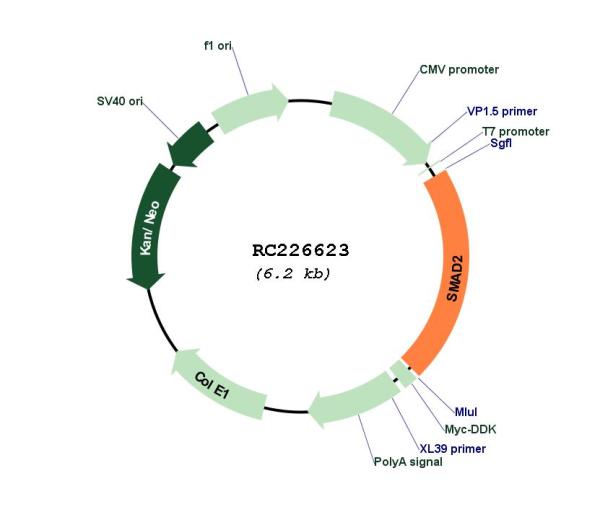SMAD2 (NM_001135937) Human Tagged ORF Clone
CAT#: RC226623
SMAD2 (Myc-DDK-tagged)-Human SMAD family member 2 (SMAD2), transcript variant 3
ORF Plasmid: tGFP
Lentiviral Particles: DDK DDK w/ Puro mGFP mGFP w/ Puro
AAV Particle: DDK
"NM_001135937" in other vectors (6)
USD 198.00
Specifications
| Product Data | |
| Type | Human Tagged ORF Clone |
| Tag | Myc-DDK |
| Symbol | SMAD2 |
| Synonyms | hMAD-2; hSMAD2; JV18; JV18-1; MADH2; MADR2 |
| Vector | pCMV6-Entry |
| E. coli Selection | Kanamycin (25 ug/mL) |
| Mammalian Cell Selection | Neomycin |
| Sequence Data |
>RC226623 representing NM_001135937
Red=Cloning site Blue=ORF Green=Tags(s) TTTTGTAATACGACTCACTATAGGGCGGCCGGGAATTCGTCGACTGGATCCGGTACCGAGGAGATCTGCC GCCGCGATCGCC ATGTCGTCCATCTTGCCATTCACGCCGCCAGTTGTGAAGAGACTGCTGGGATGGAAGAAGTCAGCTGGTG GGTCTGGAGGAGCAGGCGGAGGAGAGCAGAATGGGCAGGAAGAAAAGTGGTGTGAGAAAGCAGTGAAAAG TCTGGTGAAGAAGCTAAAGAAAACAGGACGATTAGATGAGCTTGAGAAAGCCATCACCACTCAAAACTGT AATACTAAATGTGTTACCATACCAAGGTCTCTTGATGGTCGTCTCCAGGTATCCCATCGAAAAGGATTGC CACATGTTATATATTGCCGATTATGGCGCTGGCCTGATCTTCACAGTCATCATGAACTCAAGGCAATTGA AAACTGCGAATATGCTTTTAATCTTAAAAAGGATGAAGTATGTGTAAACCCTTACCACTATCAGAGAGTT GAGACACCAGTTTTGCCTCCAGTATTAGTGCCCCGACACACCGAGATCCTAACAGAACTTCCGCCTCTGG ATGACTATACTCACTCCATTCCAGAAAACACTAACTTCCCAGCAGGAATTGAGCCACAGAGTAATTATAT TCCAGAAACGCCACCTCCTGGATATATCAGTGAAGATGGAGAAACAAGTGACCAACAGTTGAATCAAAGT ATGGACACAGGCTCTCCAGCAGAACTATCTCCTACTACTCTTTCCCCTGTTAATCATAGCTTGGATTTAC AGCCAGTTACTTACTCAGAACCTGCATTTTGGTGTTCGATAGCATATTATGAATTAAATCAGAGGGTTGG AGAAACCTTCCATGCATCACAGCCCTCACTCACTGTAGATGGCTTTACAGACCCATCAAATTCAGAGAGG TTCTGCTTAGGTTTACTCTCCAATGTTAACCGAAATGCCACGGTAGAAATGACAAGAAGGCATATAGGAA GAGGAGTGCGCTTATACTACATAGGTGGGGAAGTTTTTGCTGAGTGCCTAAGTGATAGTGCAATCTTTGT GCAGAGCCCCAATTGTAATCAGAGATATGGCTGGCACCCTGCAACAGTGTGTAAAATTCCACCAGGCTGT AATCTGAAGATCTTCAACAACCAGGAATTTGCTGCTCTTCTGGCTCAGTCTGTTAATCAGGGTTTTGAAG CCGTCTATCAGCTAACTAGAATGTGCACCATAAGAATGAGTTTTGTGAAAGGGTGGGGAGCAGAATACCG AAGGCAGACGGTAACAAGTACTCCTTGCTGGATTGAACTTCATCTGAATGGACCTCTACAGTGGTTGGAC AAAGTATTAACTCAGATGGGATCCCCTTCAGTGCGTTGCTCAAGCATGTCA ACGCGTACGCGGCCGCTCGAGCAGAAACTCATCTCAGAAGAGGATCTGGCAGCAAATGATATCCTGGATT ACAAGGATGACGACGATAAGGTTTAA >RC226623 representing NM_001135937
Red=Cloning site Green=Tags(s) MSSILPFTPPVVKRLLGWKKSAGGSGGAGGGEQNGQEEKWCEKAVKSLVKKLKKTGRLDELEKAITTQNC NTKCVTIPRSLDGRLQVSHRKGLPHVIYCRLWRWPDLHSHHELKAIENCEYAFNLKKDEVCVNPYHYQRV ETPVLPPVLVPRHTEILTELPPLDDYTHSIPENTNFPAGIEPQSNYIPETPPPGYISEDGETSDQQLNQS MDTGSPAELSPTTLSPVNHSLDLQPVTYSEPAFWCSIAYYELNQRVGETFHASQPSLTVDGFTDPSNSER FCLGLLSNVNRNATVEMTRRHIGRGVRLYYIGGEVFAECLSDSAIFVQSPNCNQRYGWHPATVCKIPPGC NLKIFNNQEFAALLAQSVNQGFEAVYQLTRMCTIRMSFVKGWGAEYRRQTVTSTPCWIELHLNGPLQWLD KVLTQMGSPSVRCSSMS TRTRPLEQKLISEEDLAANDILDYKDDDDKV |
| Chromatograms |
CHROMATOGRAMS
 Sequencher program is needed, download here. |
| Restriction Sites |
SgfI-MluI
Cloning Scheme for this gene
Plasmid Map

|
| ACCN | NM_001135937 |
| ORF Size | 1311 bp |
| OTI Disclaimer | The molecular sequence of this clone aligns with the gene accession number as a point of reference only. However, individual transcript sequences of the same gene can differ through naturally occurring variations (e.g. polymorphisms), each with its own valid existence. This clone is substantially in agreement with the reference, but a complete review of all prevailing variants is recommended prior to use. More info |
| OTI Annotation | This clone was engineered to express the complete ORF with an expression tag. Expression varies depending on the nature of the gene. |
| Product Components | The ORF clone is ion-exchange column purified and shipped in a 2D barcoded Matrix tube containing 10ug of transfection-ready, dried plasmid DNA (reconstitute with 100 ul of water). |
| Reconstitution | 1. Centrifuge at 5,000xg for 5min. 2. Carefully open the tube and add 100ul of sterile water to dissolve the DNA. 3. Close the tube and incubate for 10 minutes at room temperature. 4. Briefly vortex the tube and then do a quick spin (less than 5000xg) to concentrate the liquid at the bottom. 5. Store the suspended plasmid at -20°C. The DNA is stable for at least one year from date of shipping when stored at -20°C. |
| Reference Data | |
| RefSeq | NM_001135937.2, NP_001129409.1 |
| RefSeq ORF | 1314 bp |
| Locus ID | 4087 |
| Cytogenetics | 18q21.1 |
| Protein Families | Cancer stem cells, Druggable Genome, Embryonic stem cells, ES Cell Differentiation/IPS, Stem cell relevant signaling - JAK/STAT signaling pathway, Stem cell relevant signaling - TGFb/BMP signaling pathway, Transcription Factors |
| Protein Pathways | Adherens junction, Cell cycle, Colorectal cancer, Pancreatic cancer, Pathways in cancer, TGF-beta signaling pathway, Wnt signaling pathway |
| MW | 48.8 kDa |
| Gene Summary | The protein encoded by this gene belongs to the SMAD, a family of proteins similar to the gene products of the Drosophila gene 'mothers against decapentaplegic' (Mad) and the C. elegans gene Sma. SMAD proteins are signal transducers and transcriptional modulators that mediate multiple signaling pathways. This protein mediates the signal of the transforming growth factor (TGF)-beta, and thus regulates multiple cellular processes, such as cell proliferation, apoptosis, and differentiation. This protein is recruited to the TGF-beta receptors through its interaction with the SMAD anchor for receptor activation (SARA) protein. In response to TGF-beta signal, this protein is phosphorylated by the TGF-beta receptors. The phosphorylation induces the dissociation of this protein with SARA and the association with the family member SMAD4. The association with SMAD4 is important for the translocation of this protein into the nucleus, where it binds to target promoters and forms a transcription repressor complex with other cofactors. This protein can also be phosphorylated by activin type 1 receptor kinase, and mediates the signal from the activin. Alternatively spliced transcript variants have been observed for this gene. [provided by RefSeq, May 2012] |
Documents
| Product Manuals |
| FAQs |
| SDS |
Resources
Other Versions
| SKU | Description | Size | Price |
|---|---|---|---|
| RC226623L1 | Lenti-ORF clone of SMAD2 (Myc-DDK-tagged)-Human SMAD family member 2 (SMAD2), transcript variant 3 |
USD 757.00 |
|
| RC226623L2 | Lenti-ORF clone of SMAD2 (mGFP-tagged)-Human SMAD family member 2 (SMAD2), transcript variant 3 |
USD 757.00 |
|
| RC226623L3 | Lenti-ORF clone of SMAD2 (Myc-DDK-tagged)-Human SMAD family member 2 (SMAD2), transcript variant 3 |
USD 757.00 |
|
| RC226623L4 | Lenti-ORF clone of SMAD2 (mGFP-tagged)-Human SMAD family member 2 (SMAD2), transcript variant 3 |
USD 757.00 |
|
| RG226623 | SMAD2 (tGFP-tagged) - Human SMAD family member 2 (SMAD2), transcript variant 3 |
USD 657.00 |
|
| SC325924 | SMAD2 (untagged)-Human SMAD family member 2 (SMAD2), transcript variant 3 |
USD 503.00 |
{0} Product Review(s)
Be the first one to submit a review






























































































































































































































































 Germany
Germany
 Japan
Japan
 United Kingdom
United Kingdom
 China
China




